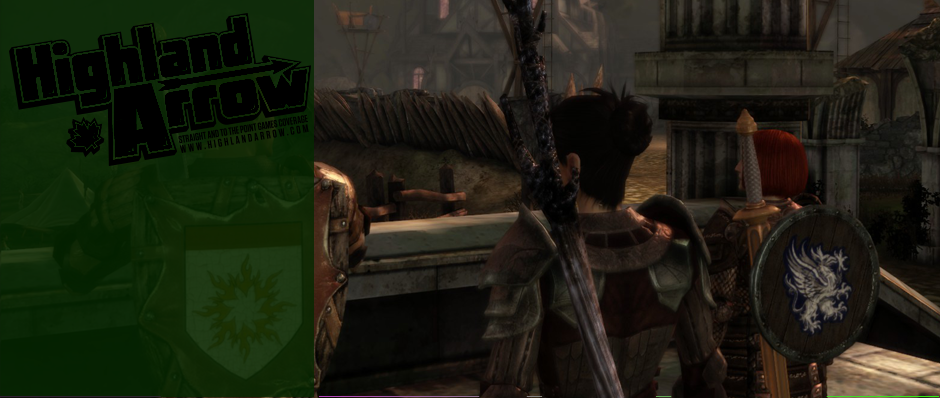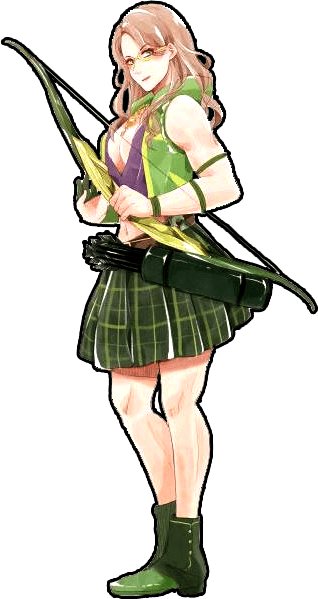

Dragon Age: Origins
Platforms: PC, XB360, PS3
Reviewed on: PC
Reviewer: Maiyannah Bishop
Review Play-Time: 22h
Developer: Bioware
Publisher: Electronic Arts
Released: 2009-11-03
Review Published: 2014-11-29
Review Updated: 2021-12-22
+ Classic western RPG experience
+ Some interesting character interactions
+ Well-realised setting and themes
+ A lot of intriguing background lore
- Very generic storyline
- A lot of quirks and bugs even to this day
- Graphical fidelity nothing special, even for the time
- Tactical combat is an exercise in frustration
- Many encounters are poorly-balanced
- Character relation system fairly annoying
- Romances awkwardly written and abjectly pandering

Dragon Age: Origins is a western RPG developed by Bioware and published by Electronic Arts. It was greatly hyped as a return to a sort of traditional western RPG that had mostly been abandoned in the AAA space (though it's worth noting that it was flourishing in the indie scene) - but what we got was a flawed work. It was lauded at the time quite highly, and it's not as if it does not deserve some of that praise, but looking forwardly to a review of the most recent installment, it is a worthwhile thing to look back on the past installments of the series. I enjoyed my time with DA:O, but it also somewhat frustrated me. It is a fairly mixed bag, but offers plenty for fans of traditional RPGs.
At it's core, what DA:O is, is a return to that western RPG formula
It's all here: the inventory management tedium, the epic fantasy settings, the elves and humans and dwarves. Dragon Age: Origins is very "safe" in that respect, you certainly won't see the blaster rifles of the late-game in Might & Magic here. It presents a fairly well-realised but generic fantasy system complete with the systematic trappings of the traditional western RPG. The UI is fairly typical with a character screen, inventory screen, and separate ones for crafting talents and for abilities. It also has a very Infinity Engine-esque (Baldur's Gate, Planescape: Torment, etc) scripting system for NPC tactics, which we'll touch on a little later. All in all this is a game made as a love letter to the genre.
The problem with this is it's not really iterating on the genre in any meaningful fashion. By that I mean to say that it is entirely generic to the format, and it isn't really adding anything to it. That's not inherently a problem in and of itself, because it's a well-proven formula in the industry that has proven highly effective. If you were looking for the next best thing in RPGs, something that shook up the genre a bit in some sort of meaningful way, though, this is not the game you are looking for, and I think a lot of people that I've read who've had problems with the game that I've read, are coming from the place of wanting that. Likely a byproduct of the hype culture of video games, and indeed, this game was massively hyped when it was coming out initially.
The world of Ferelden that DA:O details has an interesting history,
but the way it is executed graphically falls short of the mark somewhat

The one thing that Dragon Age: Origins does astoundingly well is establishing an interesting lore and background setting. Bog-standard though it may be, it is nonetheless and exceptionally-realised and rather detailed background story that has a lot of potential for the setting. It details an elaborate world and a sort of split between magic and non-magic users that feels authentic and believable, and the general cultural overtones in that feel natural rather than forced, which is a common pitfall of many fantasy settings regardless of whether they follow the conventions of the genre or not. It's fairly well-presented, and since I don't want to dig too deeply into it out of not wanting to spoil things for people that haven't played, I suppose you'll have to just take my word for it.
The art design on the other hand, is where the game loses some of that. Beyond the issues of graphical fidelity - this isn't a good-looking game even for the date of release, but neither is it ugly, merely functional - the actual art design of the game proper is as generic as it comes. There's no real sense of style, or a touch of individuality to the art design of the game. The human cities are just traditional medieval castles and similar fare. The elves are nomadic forest dwellers. The dwarves share Tolkien-esque semi-Nordic/Celtic designs. All of these places look as you would expect them to, and none of them are really any stand out nor do they offer anything particularly memorable.
Character design is one stand out, though more in the monsters than in the player characters, whom short of Alistair's impossible for medieval times hair-style are all pretty standard fare, but the design of the demonic enemies and their associated abominations is a bit of a stand out for me. That is where that otherwise-lacking graphical pizzazz and I have to concede some of the designs are interesting. The Pride demon and Desire demons were the standouts to me, as well as the abominations (mages possessed by demons), which aren't exactly breaking-the-mold-type stuff, but they are nonetheless something I found some style to.
World design is another fairly-disappointing point to be honest - while some of the locales offer much to explore, it's hard to feel compelled to explore them when after a while you quickly realise a lot of it has the certain air of the copy-paste tool about it. Many locations are blatantly copied and reused - something Bioware certainly likes to do - but it is particularly disappointing in how obvious this is, especially as you come close to the end of the game. It very much feels like a game where the shadow of that proverbial guillotine of the release date and a rapidly-dwindling budget was looming ominously overhead. It's unfortunate, as there are some interesting locales, in particular in the Dwarven city of Orzrammar and the Fade, the demonic plane, but even those start repeating, which diminishes them.
It's not bad art design. It's just overall quite average. Insipid. Run-of-the-mill. If you've played a fantasy game, you've seen all of this before.
The story is pretty generic as well, but it is written and presented quite well
The over-arching plot of the game is in defeating the darkspawn advance on Ferelden, the nation your character, irrespective of their origin, hails from. Essentially, you have to gain support from the humans, elves, and dwarves, to make the final stand both against the traitor Loghain who turns on the existing human king to seize the throne, and also face the darkspawn army threatening to descend upon the nation. The revelation about that betrayal might sound like a spoiler, but it really isn't. Along with being a part of some of the actual advertising when the game first came out, it is basically the second thing which happens in the game, no more than half an hour in (which given RPGs long running time is not long at all) The finer touches are in the actual means to do so, playing the politics of the given nations and finding some of the backstory therein. The game does a very good job of pairing up communicating the important parts of backstory with the ongoing narrative, and you're never really left wondering what is going on, which is a sign of some good writing.
It's hard to get away from the fact that this is a pretty bog-standard fantasy save the world type of story though, and while the story itself is written decently fairly, I don't think it's done enough of a job of separating itself from such origins. That said, that doesn't detract from the writing on display, but like much of the art design, it seems like a missed opportunity.
Character interactions are what carry the writing in the game

The way the characters are used as an exposition vehicle for optional back story and dialogue is really the strength of the writing in Dragon Age: Origins, as it is in most Bioware games, really. While they rely on several tropes endemic to Bioware titles past and since, they are nonetheless written in a way that is engaging and also not obstructive to the game flow, for the most part (a little more on the one problem with in that regard a little later) They all have fairly-nuanced backstories and are communicated fairly well. The voice work in particular for the companion character is a strong point, and it help carries things quite a bit through the parts that don't otherwise work very well. Voice work for the non-player characters however, is much more uneven, and there's some points where it becomes quite stilted. I think Telltale remains the only studio to make child characters that don't come across as huge bleeding stereotypes, too. Bioware sure doesn't manage that here.
The relation system the game uses is what stymies the good character writing somewhat. In theory, its a way of placing a focus on the character interactions by incentivising the player to react in ways the companion character approve of - or don't - which does a good way to highlight the various views of the companion characters, but in practise, it becomes a tiresome thing. Companions will constantly bicker over what can be the smallest things, and several times you will have progression actually stopped with conversations you cannot avoid, and when that comes just when you feel you are moving forward in the game, the net effect is it feels like the brakes just got put on the pace of the game to stop and have an entire novel read out at you. For the most part it was alright, because most of the interactions are things you could understand happening - Leliana who comes from a priestly upbringing complaining if you intimidate a priest, for example, but some of them come entirely out of the blue, and might as well be equivalent to hitting a button that reads "lower pacing, increase blood pressure" - especially knowing that you can't skip them and if you say the wrong thing you might have to kiss that high-approval stat bonus bye-bye.
That said, while those on-the-spot interactions can be rather irritating, the interactions during NPC dialogue, and the optional character interactions you can engage through the camp (which you can visit following the tutorial/prologue section) are fairly well done. In particular the quanari Sten is quite memorable, as is the golem companion Shale which is accessible from one of the DLC. They are characterful and while some of them are less interesting, they all come across rather naturally. Again, the voice acting really does carry it quite a bit.
Let's address the elephant in the room, then, the romance plots
I really hesitate to use the word romance here, and this really is my big misgiving about some of the story. There's no way to say it without getting tarred with the brush of some sex-negative neo-feminist, but I really chafe at the representation of the romance plots in the game. Each of them is very awkward and exceedingly forced. You end up doing a quest for the character in question, after which you are treated to a PG13 sex scene and that's the end of it. it's barely even acknowledged afterwards, and it comes off as pandering at the very best. Let's be honest with ourselves here: it was put into the game to sell some more copies with the titillating promise of sex, especially since there's lesbian sex, and while I don't have a problem with sex in a video game, or a highly-sexualised video game - hell, Saints Row 3 is among my favourite games of all time - but its very crass here. As I said, it's basically boiled down to a quest where the quest reward is sex. Do I think this is some sort of thing that will contribute to the downfall of all modern civilisation? No, I do not. However, it is very much something tacked-on to sell copies that is done very poorly and in an extremely shallow fashion and as such, it's to the games detriment. I really think I probably would have found the character interactions and that relation system if the "endgame" of that system wasn't so shallow and ill-conceived.
Combat is pretty functional but suffers from some pretty big gaffes

Fighting is what you're doing most of the game, and it's a fairly simple and functional hybrid real-time system. It all functions in real-time, but you can pause tactically to adjust things as needed. Each character has a hotbar of class abilities to use, and each class has several schools of abilities to chose from. For example, warriors have a generic "Warrior" ability tree, as well as sword and shield, two-weapon fighting, and two-handed weapon trees. And then they have several specializations you can unlock through gameplay for an additional tree, such as the "Templar" class for fighters that has abilities specific to fighting mages. It's a moderately-deep system rather reminiscent of the idea of the main classes and then prestige classes from 3rd edition dungeons and dragons.
The two main problems with the combat system are as follows: first of all, the AI is about as thick as bricks and requires constant hand-holding. Secondly, it's a very rock-papers-scissors system in terms of abilities and counters, which can leave you absolutely dominating some combat situations and getting absolutely wrecked others.
The AI is a big problem in the combat because it makes every combat much more of a chore than it needs to be. You're rewarded for flanking enemies and punished for letting enemies flank you, and the AI pathfinding is pretty pants, so what this means is you're constantly left needing to adjust their position again and again and again to make sure that they don't die. You have to do this almost constantly even on the easy difficulty, to say nothing of the higher difficulties where friendly-fire is possible with bows and spells. The tactics system is also MUCH less robust than the Infinity Engine games that inspired it, and your party members won't often even use abilities to save themselves from death unless you specifically tell them to. Hell, they won't even drink a potion to restore health or mana unless you specifically tell them to - and doing so takes up a precious slot or two to do so when you only four to begin with, six or seven tops usually. It's a system where the poor AI and limited means to curtail it's worst tendancies means that I'm spending most of the combat being frustrated with that AI, and given that even the original Baldur's Gate seemed to have sharper AI in that regard, it's pretty exasperating. The pathfinding becomes especially problematic in close quarters, where both enemy and ally alike will tweak out about corners and get stuck on bits of terrain. Doubling-down with the vulnerability of flanking, you'll often find your party dying to nothing more than their own stupidity.
The second part of that, which only compounds the frustration of those combats with terrain, is that certain ability sets have a very rock-paper-scissors set with each other, and if you are not careful to have certain defenses up and maneuver very specifically, you will get completely destroyed - often within seconds. Given that the AI isn't intelligent enough to fend for itself, it definitely isn't going to be able to grasp such. It has a tendency to target the enemies that can easily dispatch them, and once again, you're left having to take control to stop the AI from basically getting trashed.
Some people aren't going to be too bothered by the amount of micromanagement, but it feels disingenuous to me. This game would have been much better served by a turn-based system, and seems to have been designed to be played in that way, but it tries to be something it really is not by having that real-time aspect.
To this day, the game is quite bug-laden
I encountered quite a few replaying the game over the past week, most frequently relating to quests not advancing or completing properly, and more than a few times where party members' pathfinding would clip them into unreachable areas or get absolutely stuck in the terrain. There is one particularly persistent bug that kept me from completing the human assistance quest line because one of the demons in the fade you have to interact with to do so was spawning stuck in the floor of the area and as such wasn't triggering properly. Thankfully I'm on PC, so there are ways to work around this by essentially hacking your game or save, but you should never have to do that to progress in a game, and those kind of bugs existing this far from the original release date is pretty inexcusable.


